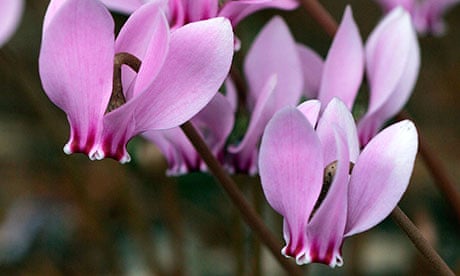In Russia, this time of year is described as velvety: heavy dews and grass growing in a last rush before the frosts, soft light, lengthening shadows and bloom on cabbages and damsons. With this change comes the push of autumn bulbs and their out-of-season energy.
The annual return of the autumn cyclamen sparks the memory of my mother and I on one of our adventures. We came upon an extensive colony growing in the unkempt garden of a nearby house up for demolition. They were hidden in brambles and we convinced ourselves that they were in the line of the bulldozers. Being the vicar's daughter, she sought permission from the contractors and in no time we were back with a spade and buckets.
They were just up, tilting back with pointed buds and the pink of opened flower a surprise in the tangle and leaf mould. Young leaves, which were waiting for rain, were coiled, tight and still embryonic in the centre of the corm. It was a shock to find that the corms were the size of tea plates and we felt like we had discovered treasure. I re-planted them lovingly in the dappled shade of a laburnum where they thrived and were soon seeding themselves to prove that they were happy.
Cyclamen hederifolium are a European native and the best colonies I have ever seen were in nut groves on a derelict section of the Appian Way in Italy. They were scattered in the hollows, where the leaf mould accumulated and where in the autumn they were free from competition. Their leaves, shaped like ivy but marbled in silver, had the run of the woods in winter when the light fell freely through the bare branches on to an empty forest floor. Find them a place that sounds something like this in a garden and they are easy, providing for you in the autumn and then retreating below ground in spring.
Their corms, can live for years, but you should never buy them dry with other autumn bulbs. First, they may have been stripped illegally from the wild and, secondly, they are easy to raise from seed.
I moved some here from a group growing outside my kitchen window in London. They were a selected white form with good silver marbling on the foliage. I had them at eye level in the half-basement window growing among Viola labradorica, which covered for their dormancy in the summer months. I could witness their return close up from this vantage point when everything around them was spent at the end of the summer.
They are struggling here, as I have them in grass under my holly tree. If there was a little more shade, so the grass grew more thinly, they would be happy but I must move them as soon as their foliage breaks through. They will be found a home with a fleet of Colchicum speciosum "Album", which I will plant under my young crab apples. Together, they will be a lovely celebration of this late flurry.
The white form of the autumn crocus is the best in my book, being spectacularly pure and standing proud and clean ahead of their foliage. Like the cyclamen, it is there for the winter. People complain about colchicum foliage but I love its glossy winter presence and its ability to vanish when the garden kicks in at the beginning of the growing season. On my sunny banks, beneath the crab apples, the grass will cover for their absence and no doubt I will forget about them until I am in need of the tonic provided by their miraculous return.
Get growing
Cyclamen hederifolium take three years to flower from seed. The pods are pulled into the heart of the plant on coils and are easy to find. Sprinkle in trays of leaf mould and keep in a shaded corner until they start to flower.
